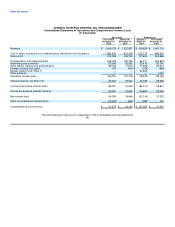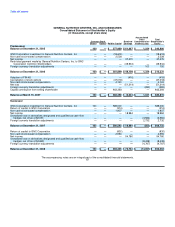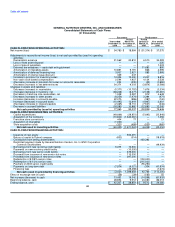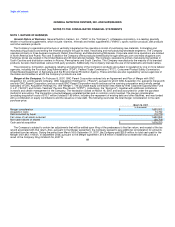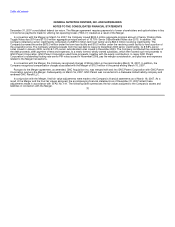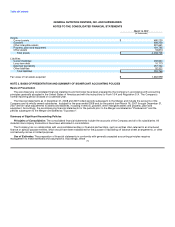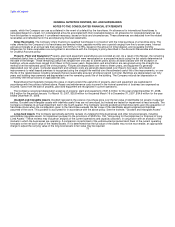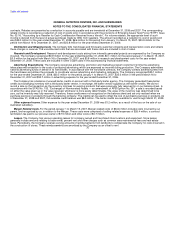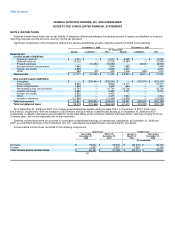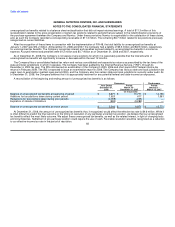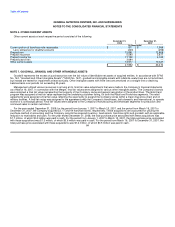GNC 2009 Annual Report Download - page 80
Download and view the complete annual report
Please find page 80 of the 2009 GNC annual report below. You can navigate through the pages in the report by either clicking on the pages listed below, or by using the keyword search tool below to find specific information within the annual report.
Table of Contents
GENERAL NUTRITION CENTERS, INC. AND SUBSIDIARIES
NOTES TO THE CONSOLIDATED FINANCIAL STATEMENTS
Revenue Recognition. The Company operates predominately as a retailer, through Company-owned stores, franchised stores and sales
through its website, www.gnc.com and to a lesser extent through wholesale operations. For all years and periods presented herein, the
Company has complied with and adopted Securities and Exchange Commission ("SEC") Staff Accounting Bulletin ("SAB") No. 104, "Revenue
Recognition."
The Retail segment recognizes revenue at the moment a sale to a customer is recorded. These revenues are recorded via the Company's
point of sale system. Gross revenues are netted against actual customer returns and an allowance for expected customer returns. The
Company records a reserve for expected customer returns based on management's estimate, which is derived from historical return data.
Revenue is deferred on sales of the Company's Gold Cards and subsequently amortized over 12 months. The length of the amortization period
is determined based on matching the discounts associated with the Gold Card program to the revenue deferral during the twelve month
membership period. For an annual fee, the card provides customers with a 20% discount on all products purchased, both on the date the card
is purchased and certain specified days of every month.
The Company also sells gift cards to its customers. Revenue from gift cards is recognized when the gift card is redeemed. These gift cards
do not have expiration dates. Based upon historical redemption rates, a small percentage of gift cards will never be redeemed, referred to as
"breakage". The Company first sold gift cards in late 2001 and the Company began to recognize gift card breakage revenue in 2008, when the
likelihood of redemption became remote. Total revenue for 2008 includes $0.6 million related to this initial recognition of gift card breakage
revenue.
The Franchise segment generates revenues through product sales to franchisees, royalties, franchise fees and interest income on the
financing of the franchise locations. See the footnote, "Franchise Revenue". These revenues are netted by actual franchisee returns and an
allowance for projected returns. The franchisees purchase a majority of the products they sell from the Company at wholesale prices. Revenue
on product sales to franchisees is recognized when risk of loss, title and insurable risks have transferred to the franchisee. Franchise fees are
recognized by the Company at the time of a franchise store opening. Interest on the financing of franchisee notes receivable is recognized as it
becomes due and payable. Gains from the sale of company-owned stores to franchisees are recognized in accordance with SFAS No. 66,
"Accounting for Sales of Real Estate". This standard requires gains on sales of corporate stores to franchisees to be deferred until certain
criteria are satisfied regarding the collectibility of the related receivable and the seller's remaining obligations. Remaining sources of franchise
income, including royalties, are recognized as earned.
The Manufacturing/Wholesale segment sells product primarily to the other Company segments, third-party customers and historically to
certain related parties. Revenue is recognized when risk of loss, title and insurable risks have transferred to the customer. The Company also
has a consignment arrangement with certain customers and revenue is recognized when products are sold to the ultimate customer.
Cost of Sales. The Company purchases products directly from third party manufacturers as well as manufactures its own products. The
Company's cost of sales includes product costs, costs of warehousing and distribution and occupancy costs. The cost of manufactured
products includes depreciation expense related to the manufacturing facility and related equipment.
Vendor Allowances. The Company enters into two main types of arrangements with certain vendors, the most significant of which results in
the Company receiving credits as sales rebates based on arrangements with such vendors ("sales rebates"). The Company also enters into
arrangements with certain vendors through which the Company receives rebates for purchases during the year typically based on volume
discounts ("volume rebates"). As the right of offset exists under these arrangements, rebates received under both arrangements are recorded
as a reduction in the vendors' accounts payable balances on the balance sheet and represent the estimated amounts due to GNC under the
rebate provisions of such 74




